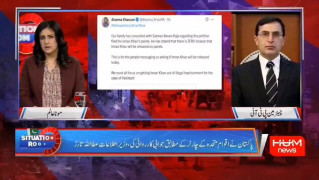
http://dawn.com/2013/04/18/banks-face-liquidity-crunch-govt-raises-only-rs28-billion/
The State Bank could hardly raise Rs28 billion for government on Wednesday through treasury bills which is much below the target of Rs175bn.
Bankers said that the market had been facing severe shortage of liquidity and that was a deliberate attempt by the central bank, signalling banks to stop rush for government papers.
The State Bank has not been pumping enough money to keep the market liquid since banks are facing shortage of over Rs600bn.
The [HI]State Bank used to inject Rs500bn or more each week[/HI] keeping the banks liquid, but still short of liquidity.
Currently banks are short of liquidity by Rs70 to Rs80bn and were unable to invest in government papers.
The [HI]State Bank gradually reduced liquidity injections in the last three months which created a gap, forcing banks to avoid lending to government,[/HI] said a senior money market player in the banking industry.
This change in the SBP’s stance came after five years. Earlier, the Central Bank had been encouraging banks to invest in government papers which loaded the government under huge debt and interest payments which sharply increased by over 60pc in the first quarter of the current fiscal year.
The treasury bills calendar issued by the State Bank showed that earlier it was planned that Rs175bn would be raised on April 17 auction of treasury bills.
The total bids just stood at Rs59bn and most of the bids were meant for three months.
Out of Rs28bn, the government raised Rs27bn for three months. No bids were offered for 12 months.
Bankers said the maturity of t-bills due on Thursday amounted to Rs148bn while the government raised just Rs28bn through auctions.
There is a [HI]huge gap between the matured amount and the amount raised[/HI] by the State Bank, creating further liquidity crunch that may affect the money market.
It was also interesting that [HI]banks were anticipating higher interest in the coming months despite low inflation[/HI].
[HI]
“This time the interest rate would not be driven by Consumer Price Index (CPI) or Sensitive Price Index (SPI). We believe the shortage of liquidity would raise demand and that would push the interest rate[/HI] in the next monetary policy,” said S S Iqbal, a money market expert.
The CPI is well below the policy interest rate of 9.5pc while analysts believe the CPI could see a further fall this month. In March, the CPI was 6.6pc on year-on-year basis.
It seems strange that the interest rate could go up under the falling inflation, but bankers insist they chose to invest in 3 months papers, anticipating that interest rate may see a hike in the next monetary policy.
COMMENTS: This is a very interesting article. I wanna share some more technical details here. Here's the OMO/POMO injection table I have put together from the SBP's daily OMO statement
[TABLE="width: 229"]
[TR]
[TD]Months
[/TD]
[TD]Rs in TRILLIONS
[/TD]
[/TR]
[TR]
[TD]April-2012[/TD]
[TD="align: right"]0.94[/TD]
[/TR]
[TR]
[TD]May-2012[/TD]
[TD="align: right"]0.58[/TD]
[/TR]
[TR]
[TD]June-2012[/TD]
[TD="align: right"]0.56[/TD]
[/TR]
[TR]
[TD]July-2012[/TD]
[TD="align: right"]1.06[/TD]
[/TR]
[TR]
[TD]August-2012[/TD]
[TD="align: right"]2.09[/TD]
[/TR]
[TR]
[TD]September-2012[/TD]
[TD="align: right"]2.10[/TD]
[/TR]
[TR]
[TD]October-2012[/TD]
[TD="align: right"]2.51[/TD]
[/TR]
[TR]
[TD]November-2012[/TD]
[TD="align: right"]2.63[/TD]
[/TR]
[TR]
[TD]December-2012[/TD]
[TD="align: right"]2.36[/TD]
[/TR]
[TR]
[TD]January-2013[/TD]
[TD="align: right"]2.37[/TD]
[/TR]
[TR]
[TD]February-2013[/TD]
[TD="align: right"]2.23[/TD]
[/TR]
[TR]
[TD]March-2013[/TD]
[TD="align: right"]2.32[/TD]
[/TR]
[TR]
[TD]TOTAL
[/TD]
[TD="align: right"]21.75[/TD]
[/TR]
[/TABLE]
Funny thing is that the article states thats State Bank has reduced its OMO liquidity injections into the market in the last 3 months whereas the reality is that the state Bank has injected about Rs7 trillion into the banking sector during that time.. Rs 7 Trillion amounts to 32% of the total liquidity injection during the last 12 months.
Also the article states that the Govt raised less money than the debt being matured. Govts role over the debt. Its like if you have Rs1000 of debt, you can always borrow Rs1,100 to pay off the previous Rs1000 and the rest of Rs100 to spend. Right now, Govt is not able to borrow because the lenders/banks think Govt cannot pay them their money back. But Asif, Govts can always print money and pay their bills. And that my friend is the "MMT" or Chartalism approach. Banks understand this that Govts can pay, but in devalued or depreciated Currency.

And check these wordings out
“This time the interest rate would not be driven by Consumer Price Index (CPI) or Sensitive Price Index (SPI). We believe the shortage of liquidity would raise demand and that would push the interest rate in the next monetary policy,”
So in short, this is going to get out of the SBP's hands to dictate the interest rates. The Bond market will force the rate onto the economy. But Asif, State Bank can always do more OMO/POMO and buy up Govt bonds and bring the rates down. Right? True! but OMO and POMOs debase the currency and leads to currency devaluation & confidence erosion. I explained this concept in my article here
http://blogs.thenews.com.pk/blogs/2012/06/the-looming-currency-crisis/
So why is the State Bank giving money to the Commercial Banks? You see Pakistan Banking sector is up to its eyeballs in Government Bonds. When inflation ticks up(currently 11% officially), banks will be forced to dump these bonds paying 12% interest for higher yields to save their capital. When that happens, values of these bonds will come down. Since these Govt bonds make the capital reserves of Banks’ balance sheets, banks will lose their capital cushion, rendering many insolvent. To avoid this, SBP is propping up Govt Bond prices to keep the banks from crashing. But SBP cant continue this for long because it risks devaluing Rupee. SBP will find itself cornered, whether to save the banks or the Rupee.
Someone on Twitter asked me what the banks are going to buy with the proceeds from those Govt Bonds. Dollars.. One Hundred Dollar bills and US TBills parked at the NY Fed. This is the reason why dollar has remained strong. Precarious times I tell ya.. precarious times.































